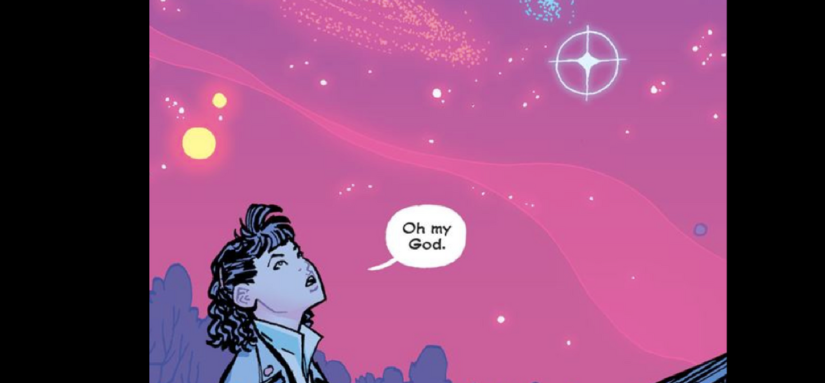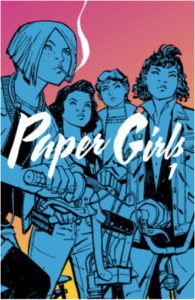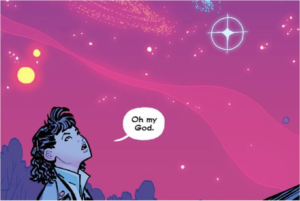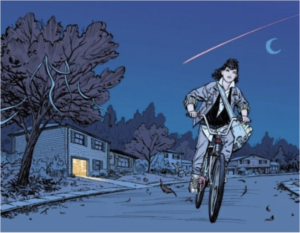I have a bad habit of buying #1s of all of the series I’m interested in, and then either letting the single issues stack up or buying the trade when that drops. In Binge-Reading, an ongoing series of articles I do for Blastoff, I catch up on everything I’ve been missing since falling off the monthly train. This month, we’re heading back to 1988 with the Paper Girls.
If you frequent this website, you may have noticed – here , or here – that I’m a pretty huge Brian K. Vaughan fan. In a post-Saga world, though, there aren’t many who aren’t on the BKV train. There was a time where I couldn’t go into a comic shop without hearing someone sing the praise of Saga – and that praise is entirely deserved. When I started reading comics, Y: The Last Man and Ex Machina were both headed toward their finales, and both of those books were formative for me in showing me what this medium can be when writers and artists soar together… so being around for the full run of Brian K. Vaughan’s next big series was a huge deal for me. Here’s the thing, though – I love Saga. Really do. But ever since Paper Girls #1 dropped from Image in October 2015, I can’t help but wonder why the industry isn’t freaking out about this book the way they freaked out about Saga.
Because again… I looove Saga. Don’t get me wrong.
But freakin’ PAPER GIRLS.
I read the first few issues as they came out, but today I decided it was time to settle down with the two trade paperbacks that have been published and get caught up. As always, Brian K. Vaughan’s characters and dialogue put him in an almost singular category as a comics writer, but I have noticed something about his work. It happened for me with Y: The Last Man, Ex Machina, Runaways, and Saga… I start at #1, and always enjoy it right away. I carry on, having a great time reading until suddenly, seemingly out of nowhere, I fall deeply in love. BKV is a master of that slow burn narrative, creating highly readable stories that hook your interest immediately and then hook your passion a little while later. That didn’t happen in Paper Girls. The oversized first issue is what made me instantly, deeply invested in Erin, Mac, Tiffany, and and KJ’s story. It opens with a nightmare of hellish proportions, and then cuts to Erin waking up in time to begin her early morning shift as a paper girl (obv), but the minimalistic wring and the art work together to make this scene a masterpiece. As Erin gets ready for her day in the confines of her home, the pages are busy with six and seven panels, but then the page turn reveals one of my favorite double-page spreads I’ve seen in a comic. Erin, free from her nightmare and her home, pedals down the open road, leaning into her handlebars, as red streaks through the sky behind her. It’s simple, and it’s stunning, and it’s one of the best damn openings I’ve ever read.
The rest of the comic more than lives up to the first chapter as the story takes a sharp turn from an 80s Stand by Me-esque thriller to a time-travel epic as dinosaurs appear in the 80s, girls from the 80s are blasted into 2016, and a mysterious device from an as-of-yet unrevealed timeline ends up guiding our girls through an unfamiliar future. On the art front, co-creator Cliff Chiang is a brilliant crafstman and, fresh off of his epic Wonder Woman run, is producing the best work of his career here. His characters are alive, his monsters – oh, there are monsters – are terrifying, and his scenery seems to exude music… honestly, mostly the Stranger Things theme. (Yes, I know Paper Girls came first. Still.) Cliff is among my favorite working artists, and colorist Matt Wilson, who rounds out this team of stellar creators, is by far my favorite colorist working today. He is muted yet bright, flat yet vibrant, and the perfect partner for Cliff to create the beautiful, strange world of Paper Girls. From the interior work to the design, there is very much nothing else on the shelves like this book which, evident especially in the first volume, reinvents itself and sharply changes directly almost every issue. On the lettering from, Jared K. Fletcher does terrific work here, playing with subtle tricks that are unique and visually interesting without jarring the reader out of the narrative. Mac’s reaction to the reveal of what the hooded guys look like comes to mind: her speech bubble is filled with whatishappeningwhatishappening repeated over and over. Like John Layman’s lettering on Chew, the sparing but engaging lettering tricks go a long way.
Concisely told and filled with heart, pain, and fun, Paper Girls is an amazing accomplishment of craft, both writing and art. With just two volumes published so far, it has the potential to become Brian K. Vaughan’s best work. I can’t wait to see how it wraps up, but I hope we take a good long while to get there.





Comments are closed.